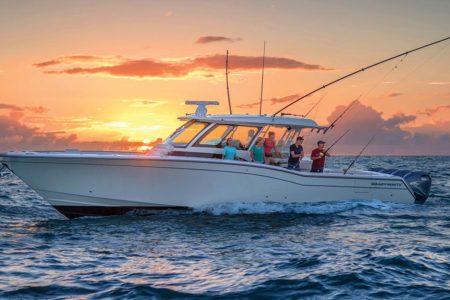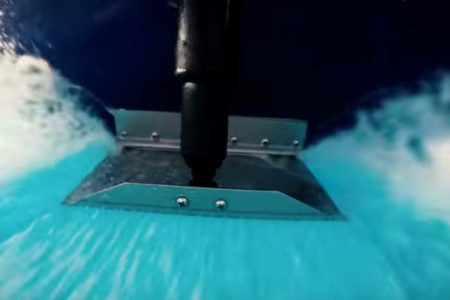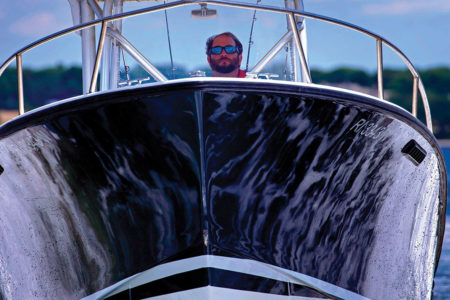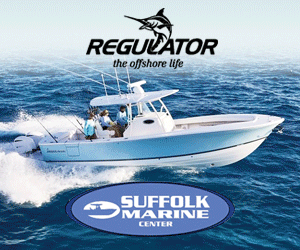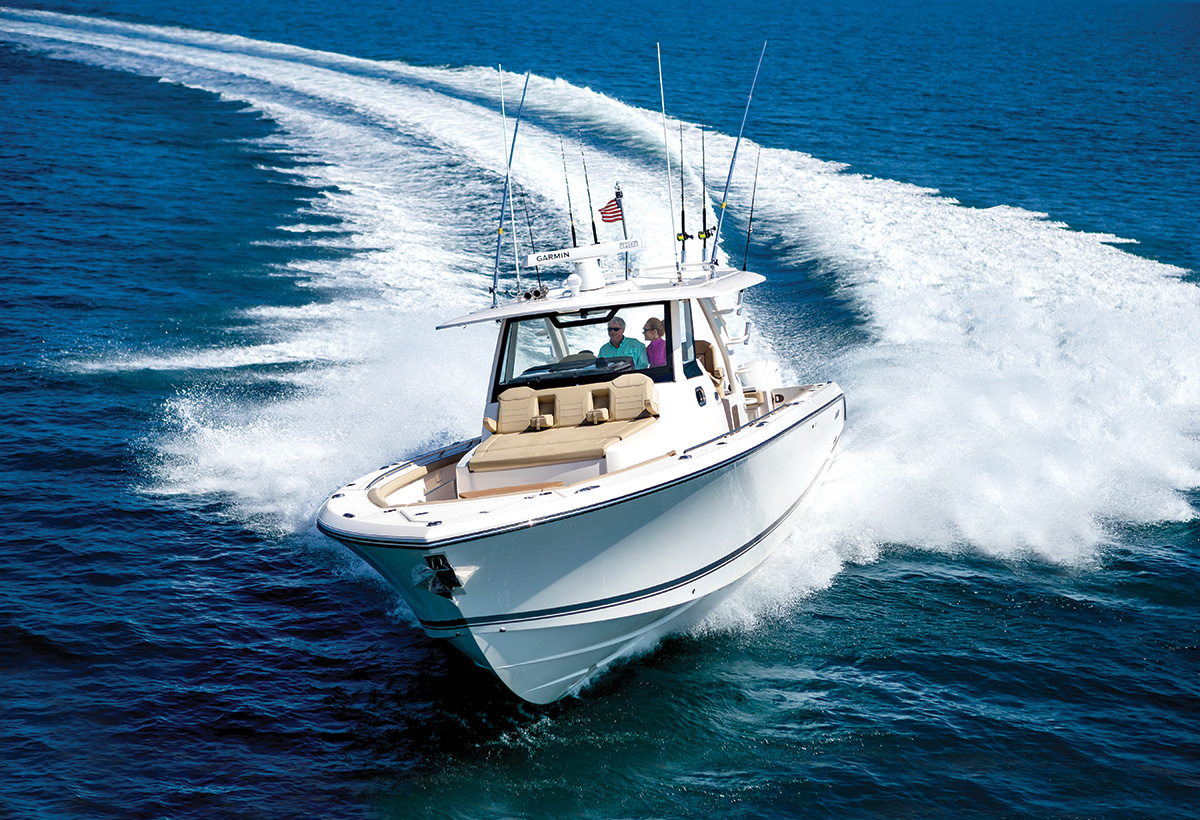
What is luxury on a sport fishing or family fishing boat? Ask any 10 owners and you are likely to get an equal number of answers. Spending money on marginally useful accessories and creature comforts just to show off to the guys at the dock is a foreign subject to me and probably to a lot of Fisherman readers who have to work hard to save extra cash to equip their ride. If I am going to put something on an existing boat, or order an optional feature on a new one, it needs to have real value and either help me catch more fish, make my vessel run more safely or efficiently, or add some additional ergonomics or crew comfort in the process. I guess you can term this concept “functional luxury”—spending money for an item on your vessel that will really make a difference. With that thought as our singular focus for this month’s Boat Sense column, here are a dozen “functional luxury” items that were once the exclusive to larger and more expensive craft and are now being included as either standard or optional features on many outboard powered center consoles, dual consoles and cabin boats in the 21-to30-foot range.
SiriusXM Weather
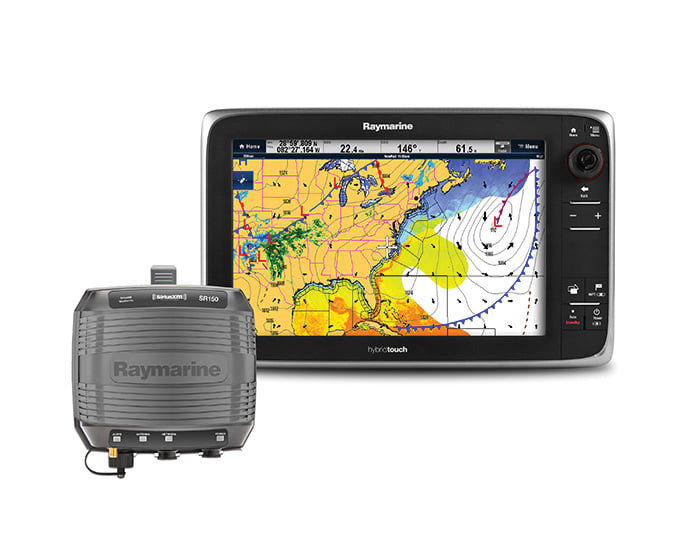 This is my “go-to” add-on accessory that I will soon install on my MarCeeJay. This feature enabled me to avoid some potentially devastating thunderstorms and rough seas on a recent away charter. I experienced firsthand the trip safety that real time SiriusXM weather capability can accomplish. Many current chartplotters feature a plug-in weather module that is compatible with the SiriusXM suite of services, which include music, storm radar, sea temps, wind reports and weather forecasting, available as a monthly service ranging from $15to$55 per month, depending on the features you select. You can sign up for six months and take six months off when your boat is high and dry for the winter. This one is a keeper and most Fisherman readers can add this to their boats with a minimum of difficulty.
This is my “go-to” add-on accessory that I will soon install on my MarCeeJay. This feature enabled me to avoid some potentially devastating thunderstorms and rough seas on a recent away charter. I experienced firsthand the trip safety that real time SiriusXM weather capability can accomplish. Many current chartplotters feature a plug-in weather module that is compatible with the SiriusXM suite of services, which include music, storm radar, sea temps, wind reports and weather forecasting, available as a monthly service ranging from $15to$55 per month, depending on the features you select. You can sign up for six months and take six months off when your boat is high and dry for the winter. This one is a keeper and most Fisherman readers can add this to their boats with a minimum of difficulty.
Wi-Fi & Bluetooth Capability
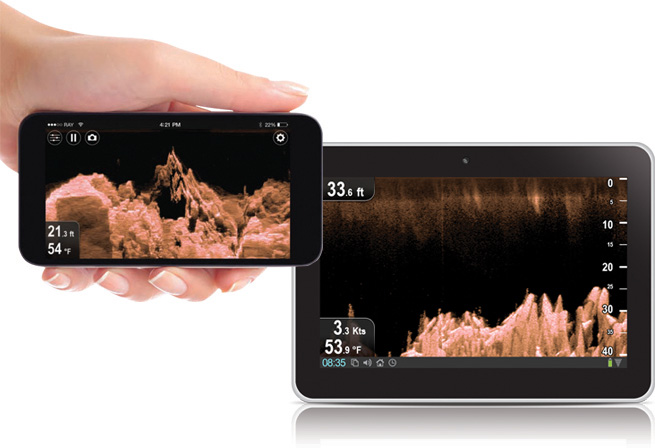 Wi-Fi and Bluetooth are becoming more imbedded in our everyday lives and have made their way into the boating world as well. In the majority of situations, the heart of the onboard wireless system is your multifunction display chartplotter. All of the data collected by the chartplotter and its various sensors (position, vessel speed, course, time to destination, etc.) and the echo sounder if it’s a combo unit (depth, sea temp, etc.) can be transmitted to various devices onboard via a Bluetooth or Wi-Fi antenna that is either built-in or added to your MFD unit. Just download an app from the manufacturer of your marine electronics and you can get it started and be totally amazed as to what you can see and control on these portable ancillary devices (phone, tablet, laptop, etc.). You can also play your tunes stored in your phone via Bluetooth connectivity to your next-gen onboard stereo system to entertain your crew dockside, at the beach and when trolling the 100-fathom line. This is definitely the wave of the future and the sooner you get onboard, the more user functionality you will enjoy.
Wi-Fi and Bluetooth are becoming more imbedded in our everyday lives and have made their way into the boating world as well. In the majority of situations, the heart of the onboard wireless system is your multifunction display chartplotter. All of the data collected by the chartplotter and its various sensors (position, vessel speed, course, time to destination, etc.) and the echo sounder if it’s a combo unit (depth, sea temp, etc.) can be transmitted to various devices onboard via a Bluetooth or Wi-Fi antenna that is either built-in or added to your MFD unit. Just download an app from the manufacturer of your marine electronics and you can get it started and be totally amazed as to what you can see and control on these portable ancillary devices (phone, tablet, laptop, etc.). You can also play your tunes stored in your phone via Bluetooth connectivity to your next-gen onboard stereo system to entertain your crew dockside, at the beach and when trolling the 100-fathom line. This is definitely the wave of the future and the sooner you get onboard, the more user functionality you will enjoy.
Big Screen Multi-Function Displays
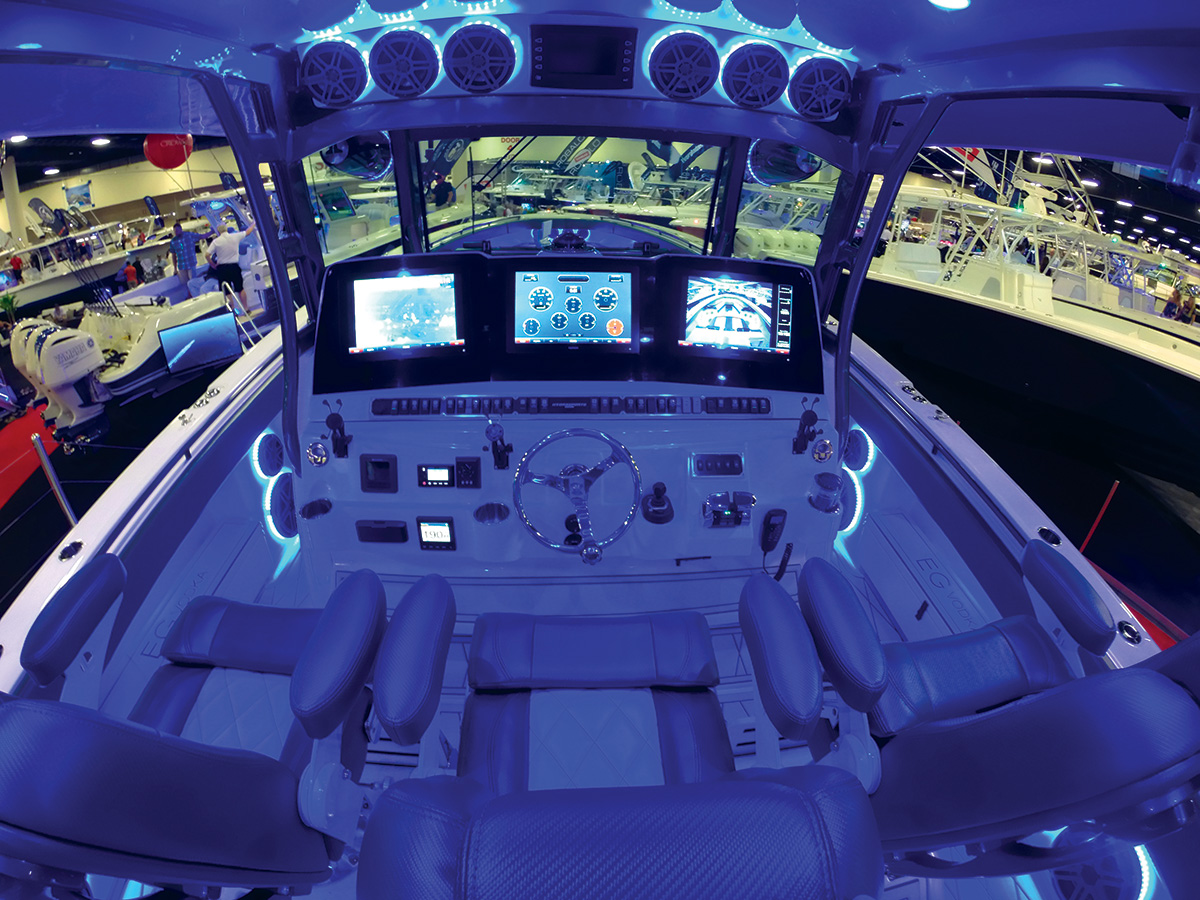 I knew that the paradigm for big-screen MFDs had shifted in favor of small boaters when I attended last year’s Ft. Lauderdale Boat Show and observed how many 21-to25-foot boats were being equipped with a minimum 12-inch multi-function display at the helm, with others offering twin 10-inch or 12-inch screens! As my eyes age, the 6- and 7-inch displays just don’t cut it anymore and I am considering upgrading my 228 EdgeWater with twin 9-inch displays as a winter project for next season. With the wealth of data that most onboard GPS navigators, echo sounders, radars and ancillary instruments provide, there is no substitute for having the largest display possible to be able to use this data to your advantage, either for navigation, fuel efficiency, weather safety or fish finding.
I knew that the paradigm for big-screen MFDs had shifted in favor of small boaters when I attended last year’s Ft. Lauderdale Boat Show and observed how many 21-to25-foot boats were being equipped with a minimum 12-inch multi-function display at the helm, with others offering twin 10-inch or 12-inch screens! As my eyes age, the 6- and 7-inch displays just don’t cut it anymore and I am considering upgrading my 228 EdgeWater with twin 9-inch displays as a winter project for next season. With the wealth of data that most onboard GPS navigators, echo sounders, radars and ancillary instruments provide, there is no substitute for having the largest display possible to be able to use this data to your advantage, either for navigation, fuel efficiency, weather safety or fish finding.
Radar
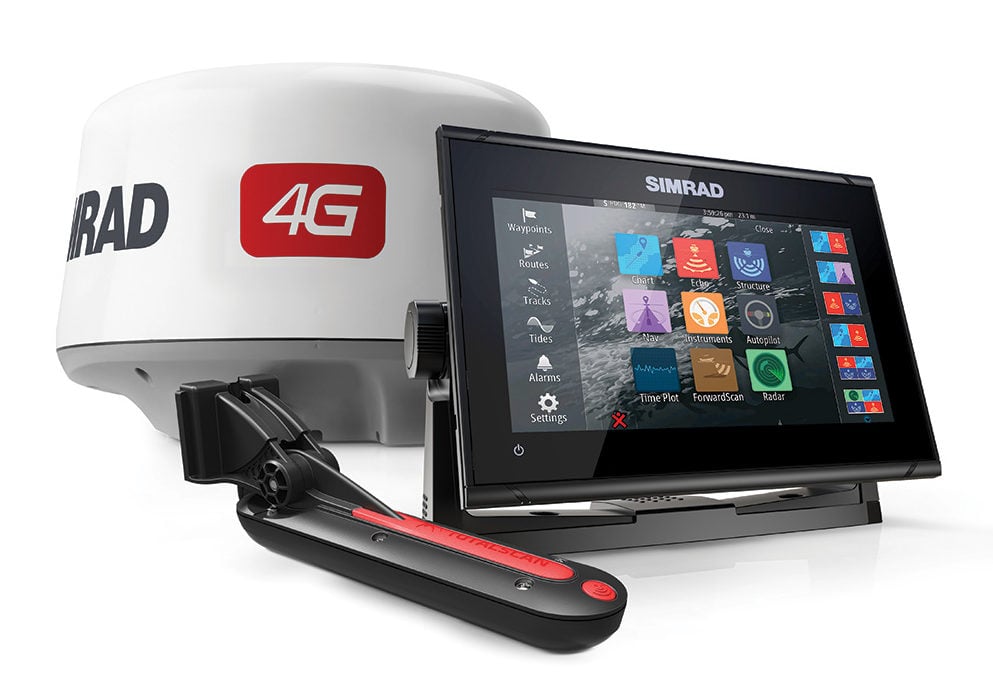 Radar was once the exclusive domain of boats 30 feet and up, equipped with large hardtops and 4-to6-foot wide open array antennas. That has all changed over the past decade, first with the introduction of enclosed radomes in the 18-to24-inch diameter range. But the real paradigm-shift came with the introduction of completely sealed and independent plug-and-play radar modules, where if the user wants to add a radar capability to a big-screen display, all that’s required is to mount the dome up top, plug the wire into the back of the MFD and hook it up to an onboard power supply. High-definition radar is a recent phenomenon, making it even more effective and user-friendly. Most basic plug-and-play radar modules are priced from $1,300 to $1,700, and all of the major electronics manufacturers offer this capability in their MFD package deals.
Radar was once the exclusive domain of boats 30 feet and up, equipped with large hardtops and 4-to6-foot wide open array antennas. That has all changed over the past decade, first with the introduction of enclosed radomes in the 18-to24-inch diameter range. But the real paradigm-shift came with the introduction of completely sealed and independent plug-and-play radar modules, where if the user wants to add a radar capability to a big-screen display, all that’s required is to mount the dome up top, plug the wire into the back of the MFD and hook it up to an onboard power supply. High-definition radar is a recent phenomenon, making it even more effective and user-friendly. Most basic plug-and-play radar modules are priced from $1,300 to $1,700, and all of the major electronics manufacturers offer this capability in their MFD package deals.
LED Trim Tab Indicators with Auto Retract
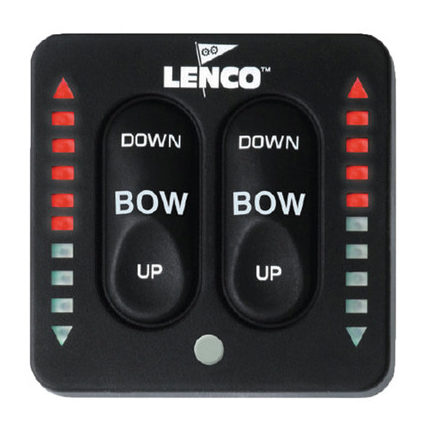 This is another of the must-have upgrades that I will add to my boat during the coming winter layover. If your vessel is equipped with Lenco electric trim tabs, which is one of the most popular OEM brands these days among major manufacturers, upgrading to the LED tactile trim tab panel offers two distinct operation benefits. First, there is no guesswork when working the tab positions, since the LED indicators positioned on either side of the trim tab switch panel let you know the precise angle of attack of each trim plane. Secondly, at the end of each trip, an auto-retract feature brings each tab up into the neutral position when you turn off your ignition, so that you can start off fresh for the next trip. Frequently, with no indicators to let you know the current trim tab position and with the tab piston rods exposed to the underwater elements, two potential negatives occur. One, you can take off on your next trip with the boat in a less than optimum trim angle; and second, barnacles can attach themselves to the metal actuating rods on each tab and compromise their operation. Both of these problems are solved nicely with the LED tactile switch with auto retract feature.
This is another of the must-have upgrades that I will add to my boat during the coming winter layover. If your vessel is equipped with Lenco electric trim tabs, which is one of the most popular OEM brands these days among major manufacturers, upgrading to the LED tactile trim tab panel offers two distinct operation benefits. First, there is no guesswork when working the tab positions, since the LED indicators positioned on either side of the trim tab switch panel let you know the precise angle of attack of each trim plane. Secondly, at the end of each trip, an auto-retract feature brings each tab up into the neutral position when you turn off your ignition, so that you can start off fresh for the next trip. Frequently, with no indicators to let you know the current trim tab position and with the tab piston rods exposed to the underwater elements, two potential negatives occur. One, you can take off on your next trip with the boat in a less than optimum trim angle; and second, barnacles can attach themselves to the metal actuating rods on each tab and compromise their operation. Both of these problems are solved nicely with the LED tactile switch with auto retract feature.
Retractable and Drop-Down Seating
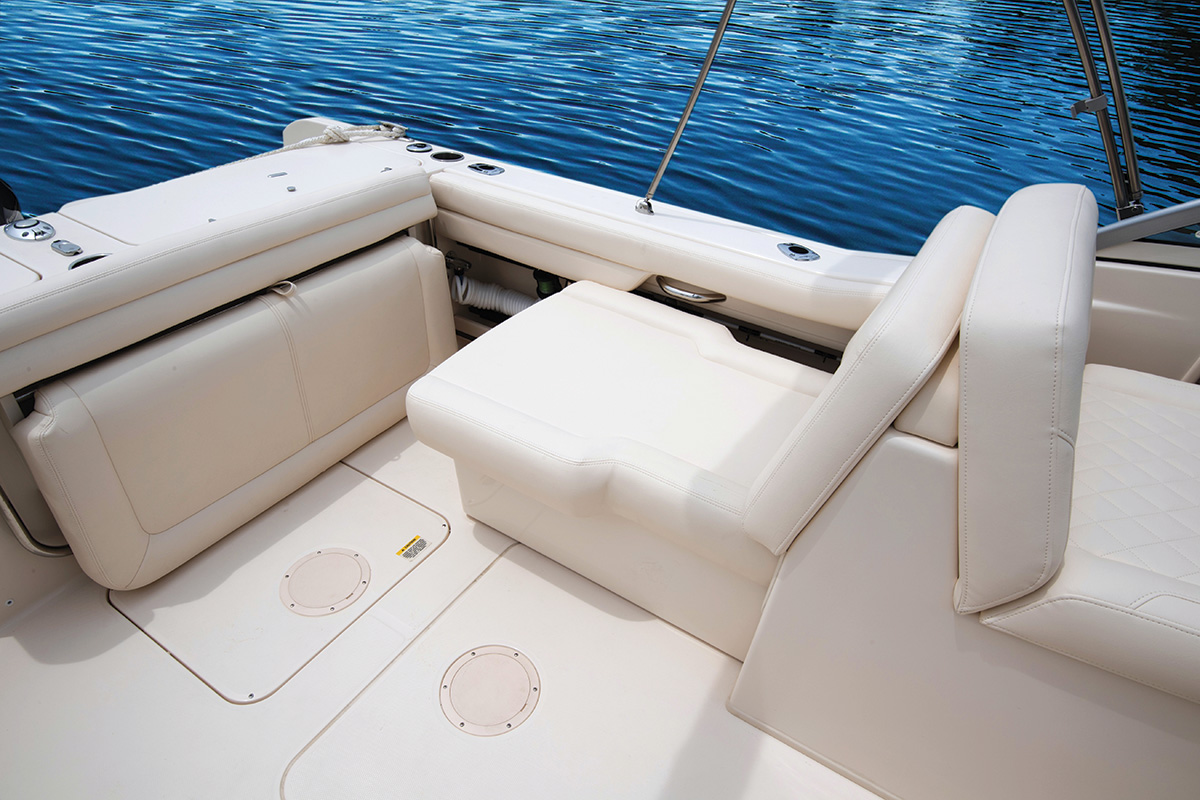 Decades ago, Wiley Corbett, Grady-White’s former General Manger, shared some intimate boating knowledge with me at their booth at the NY Boat Show and it was simply, “John, seats sell boats!” Indeed they do, especially when your wife, significant other, family or crew has anything to say about it. The problem with stationery seats located in the cockpit is that they get in the way when it’s time to bend the rods. Fast-forward to the recently introduced lineup of 2018 family sport boats and fishing machines where a lot has changed. It’s a case of now you see it, now you don’t when it comes to the concept of crew seating. Layout engineers have become very creative when designing modern sportfishers, dual consoles and center consoles, employing drop-down bench seats, dual purpose back rests that double as coaming bolsters, sliding lounge seats and up/down back and lumbar bolsters on helm chairs and leaning posts. Having a plush ergonomic doublewide aft bench seat that drops down out of the way when it’s time to fish is a major plus for any fishing boat. If I were buying a new rig, I would certainly budget some extra dead presidents to focus on upgraded flexible operator and crew seating, since most of your trips are a long day out on the water, you might as well be comfortable.
Decades ago, Wiley Corbett, Grady-White’s former General Manger, shared some intimate boating knowledge with me at their booth at the NY Boat Show and it was simply, “John, seats sell boats!” Indeed they do, especially when your wife, significant other, family or crew has anything to say about it. The problem with stationery seats located in the cockpit is that they get in the way when it’s time to bend the rods. Fast-forward to the recently introduced lineup of 2018 family sport boats and fishing machines where a lot has changed. It’s a case of now you see it, now you don’t when it comes to the concept of crew seating. Layout engineers have become very creative when designing modern sportfishers, dual consoles and center consoles, employing drop-down bench seats, dual purpose back rests that double as coaming bolsters, sliding lounge seats and up/down back and lumbar bolsters on helm chairs and leaning posts. Having a plush ergonomic doublewide aft bench seat that drops down out of the way when it’s time to fish is a major plus for any fishing boat. If I were buying a new rig, I would certainly budget some extra dead presidents to focus on upgraded flexible operator and crew seating, since most of your trips are a long day out on the water, you might as well be comfortable.
Bow Thrusters
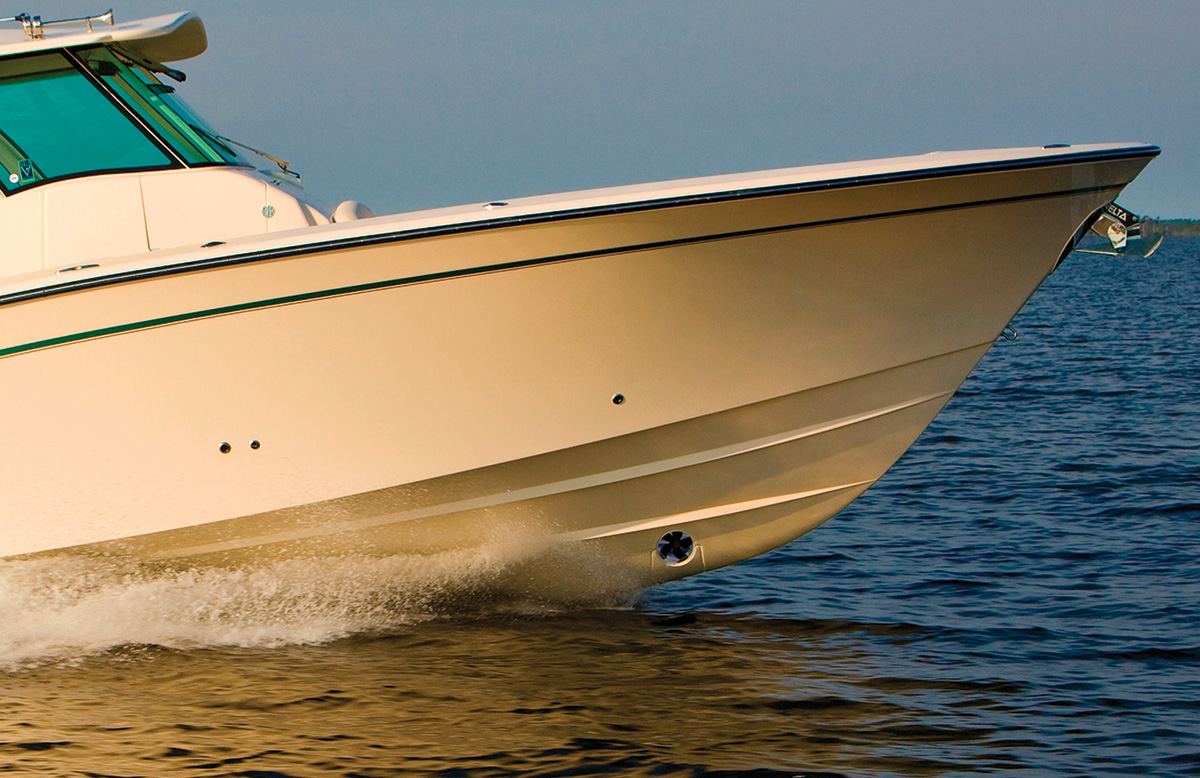 Once considered an esoteric upgrade for single inboard engine cruisers and lobster boats, bow thrusters should have considerable appeal to anyone who drives a single outboard powered center console, dual console or cabin boat in the 21-to26-foot range. Things can get hairy when you are trying to dock your boat into a confined dock space with both a crosswind and current that are collaborating to ruin your day. This is where a bow thruster comes into play and can create true peace of mind with the flick of a switch. Sure, they make a lot of whirring noises when you energize the controls, but there’s beauty in all of that racket when you can effortlessly bring your bow back into the wind and slide easily into your marina slip.
Once considered an esoteric upgrade for single inboard engine cruisers and lobster boats, bow thrusters should have considerable appeal to anyone who drives a single outboard powered center console, dual console or cabin boat in the 21-to26-foot range. Things can get hairy when you are trying to dock your boat into a confined dock space with both a crosswind and current that are collaborating to ruin your day. This is where a bow thruster comes into play and can create true peace of mind with the flick of a switch. Sure, they make a lot of whirring noises when you energize the controls, but there’s beauty in all of that racket when you can effortlessly bring your bow back into the wind and slide easily into your marina slip.
Next-Gen Coolers
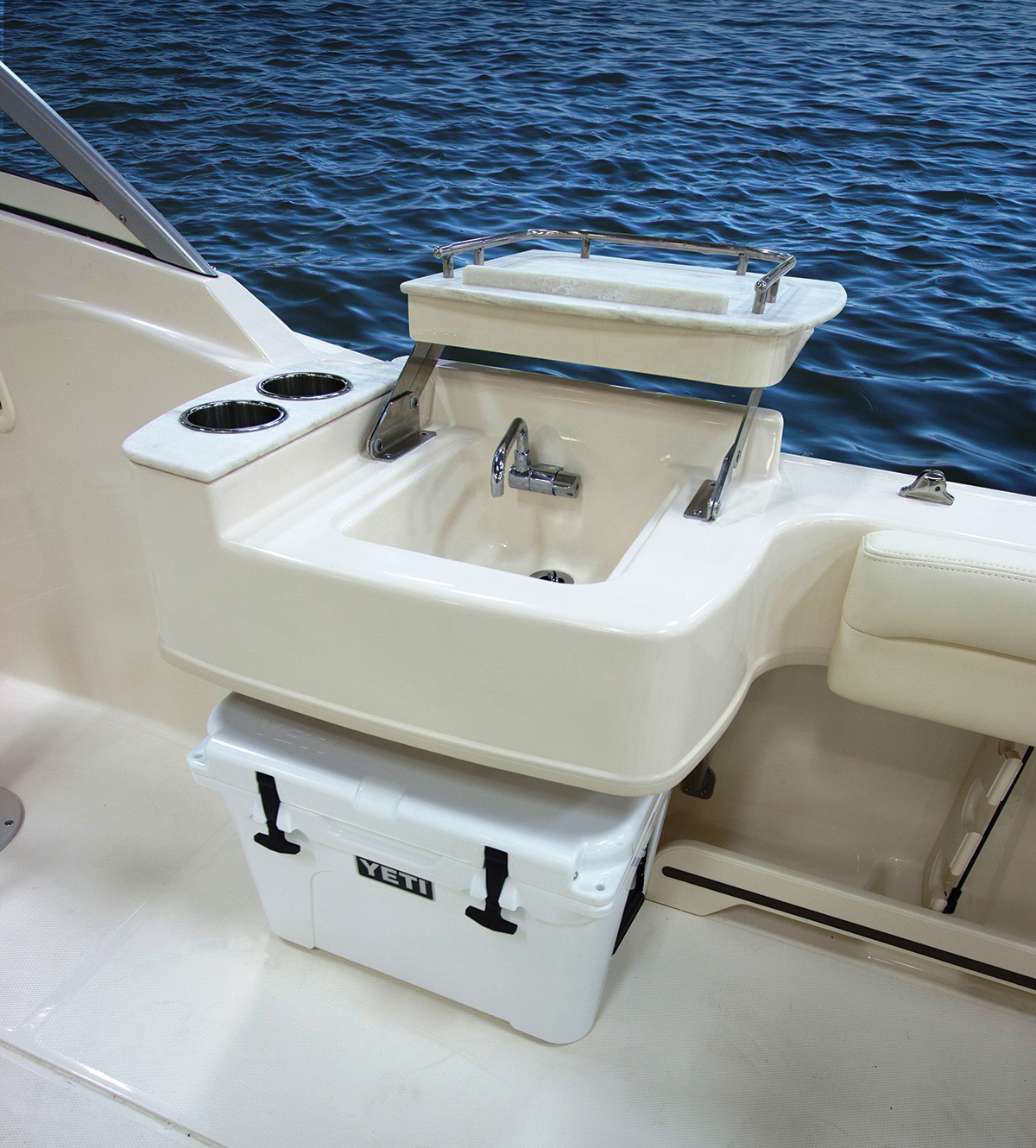 Let’s face it, despite their extremely top-shelf cost, roto-molded “designer” coolers like the Yeti, Engel, Icy-Tek, Canyon, Igloo Sportsman and others are here to stay. Independent tests have shown that they keep ice longer, fish cooler and beverages frostier than their plain-Jane counterparts and there’s a certain “Cadillac” element to the purchase as well, telling your neighbors down at the marina that you will settle for nothing but the best. They’re also more durable and “grizzly-proof.” Top builders are starting to include these as either standard or optional equipment on their boats, so in some cases, they are making the choice for you. I have used the Canyon and Igloo Sportsman next-gen coolers on my MarCeeJay and both have performed beyond my wildest expectations – they really deliver as advertised. I have kept ice in them for over a week, sitting out in the hot August sun! Some of the secrets to their collective big chill factor are a thick 2-inch urethane foam floatation throughout, sturdy outer and inner roto-molded polyethylene skins that clean up easy and don’t retain odors, plus heavy-duty hardware that keeps them locked up tight as a drum along with gasketed lids to retain the internal frostiness.
Let’s face it, despite their extremely top-shelf cost, roto-molded “designer” coolers like the Yeti, Engel, Icy-Tek, Canyon, Igloo Sportsman and others are here to stay. Independent tests have shown that they keep ice longer, fish cooler and beverages frostier than their plain-Jane counterparts and there’s a certain “Cadillac” element to the purchase as well, telling your neighbors down at the marina that you will settle for nothing but the best. They’re also more durable and “grizzly-proof.” Top builders are starting to include these as either standard or optional equipment on their boats, so in some cases, they are making the choice for you. I have used the Canyon and Igloo Sportsman next-gen coolers on my MarCeeJay and both have performed beyond my wildest expectations – they really deliver as advertised. I have kept ice in them for over a week, sitting out in the hot August sun! Some of the secrets to their collective big chill factor are a thick 2-inch urethane foam floatation throughout, sturdy outer and inner roto-molded polyethylene skins that clean up easy and don’t retain odors, plus heavy-duty hardware that keeps them locked up tight as a drum along with gasketed lids to retain the internal frostiness.
Integrated Windlass with External or Remote Controls
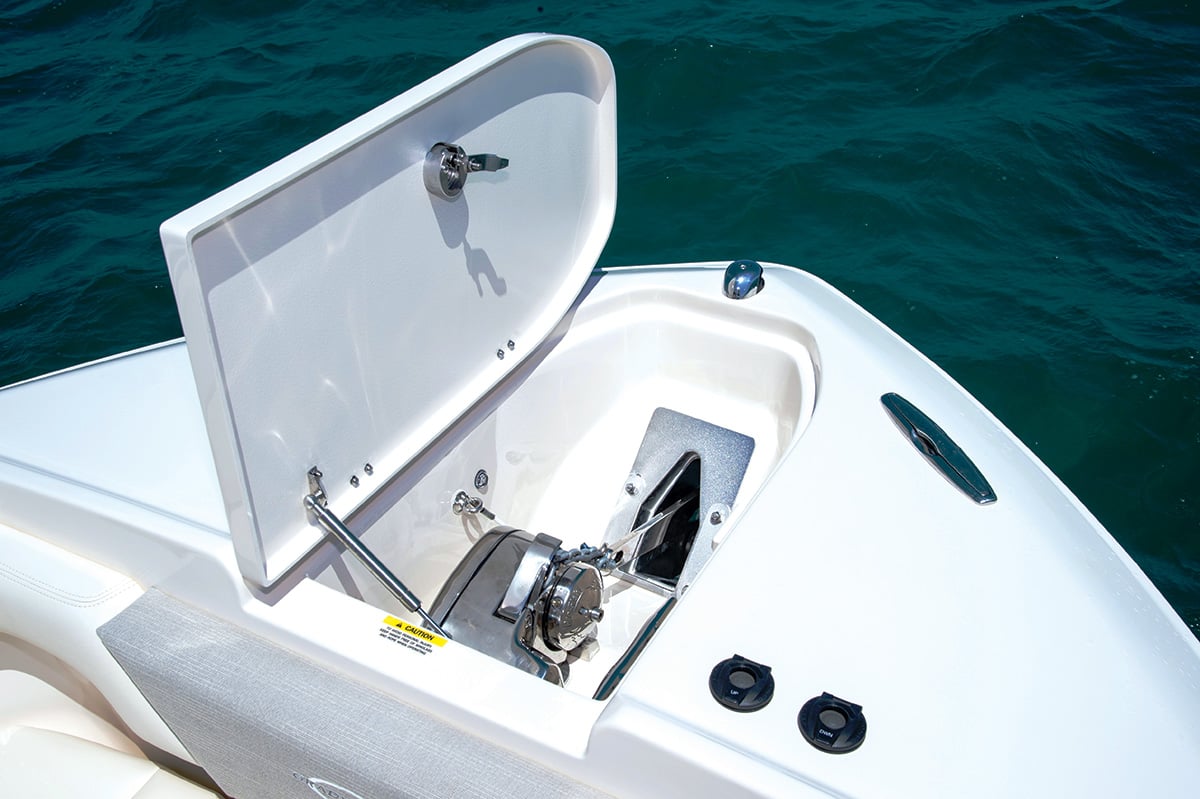 Some boat manufacturers are now offering the ability to control your anchor windlass from the helm or anywhere else onboard via wireless connectivity. Yet another option is to work the windlass from the bow via standard electronic pushbutton controls, where you can better see what’s going on with your anchor, chain and rode from firsthand observation. Both methods offer increased flexibility to the standard helm-mounted control that relies on communication with another crewmember to know if everything in the anchor system is working up to expectations. Both options are something to ponder when ordering a new boat or upgrading an older favorite.
Some boat manufacturers are now offering the ability to control your anchor windlass from the helm or anywhere else onboard via wireless connectivity. Yet another option is to work the windlass from the bow via standard electronic pushbutton controls, where you can better see what’s going on with your anchor, chain and rode from firsthand observation. Both methods offer increased flexibility to the standard helm-mounted control that relies on communication with another crewmember to know if everything in the anchor system is working up to expectations. Both options are something to ponder when ordering a new boat or upgrading an older favorite.
LED Lighting
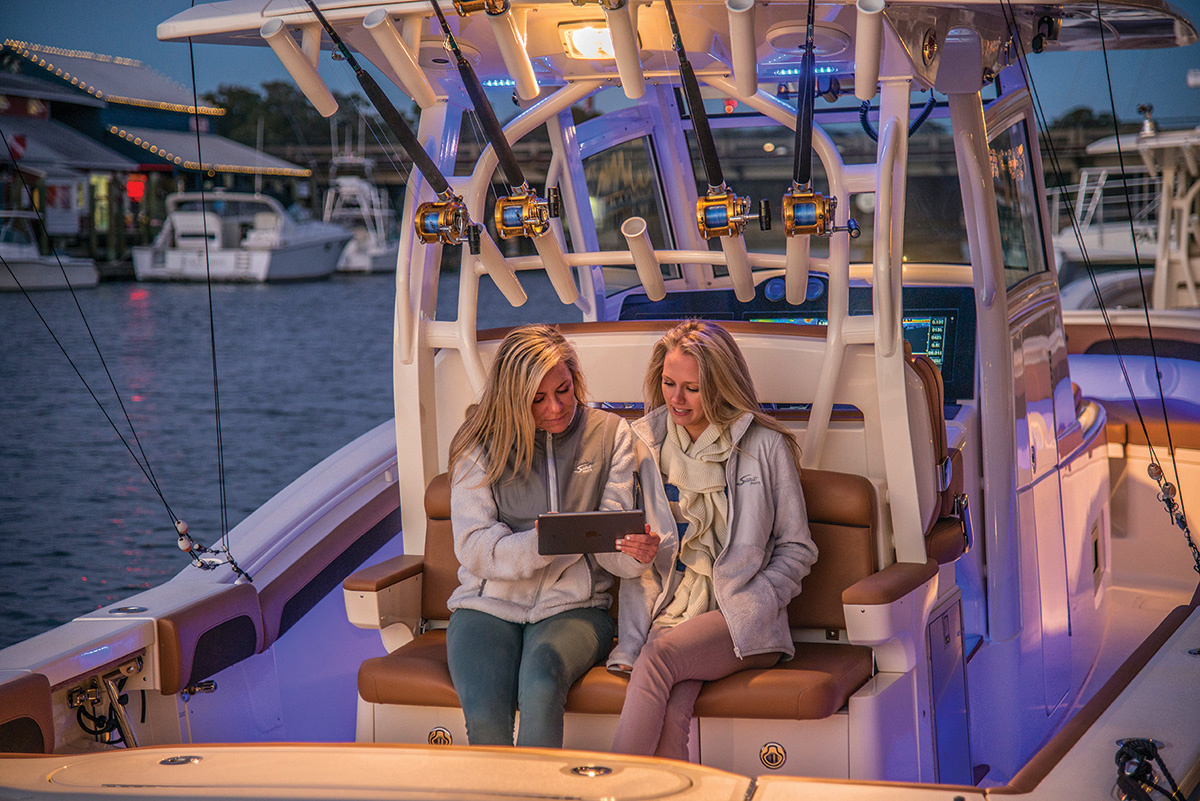 Once considered an expensive novelty, light emitting diode(LED) lighting is the new normal and more manufacturers are offering LEDs as standard issue on their 2017 and upcoming 2018 model year boats. Besides producing a crisper and cleaner source of illumination with enhanced visibility, LED lighting uses significantly less 12V battery power to get the job done. How much? Name brand LED running lights (Perko, Hella, etc.) consume over 90% less battery power than their incandescent brethren, are more durable and weather resistant and typically hold their brightness levels for significantly longer time periods too! I have upgraded my 228 EdgeWater cc to LEDs and will probably do the same to its little sister the 185cc at some point soon. If you have the option to add LED Nav, cockpit and interior lights to your ride, go for it, you will not be disappointed and it’s worth the investment. LED running lights are way cool too and the next-gen models are smaller, more powerful and use less battery power to function.
Once considered an expensive novelty, light emitting diode(LED) lighting is the new normal and more manufacturers are offering LEDs as standard issue on their 2017 and upcoming 2018 model year boats. Besides producing a crisper and cleaner source of illumination with enhanced visibility, LED lighting uses significantly less 12V battery power to get the job done. How much? Name brand LED running lights (Perko, Hella, etc.) consume over 90% less battery power than their incandescent brethren, are more durable and weather resistant and typically hold their brightness levels for significantly longer time periods too! I have upgraded my 228 EdgeWater cc to LEDs and will probably do the same to its little sister the 185cc at some point soon. If you have the option to add LED Nav, cockpit and interior lights to your ride, go for it, you will not be disappointed and it’s worth the investment. LED running lights are way cool too and the next-gen models are smaller, more powerful and use less battery power to function.
Joystick Engine Controls
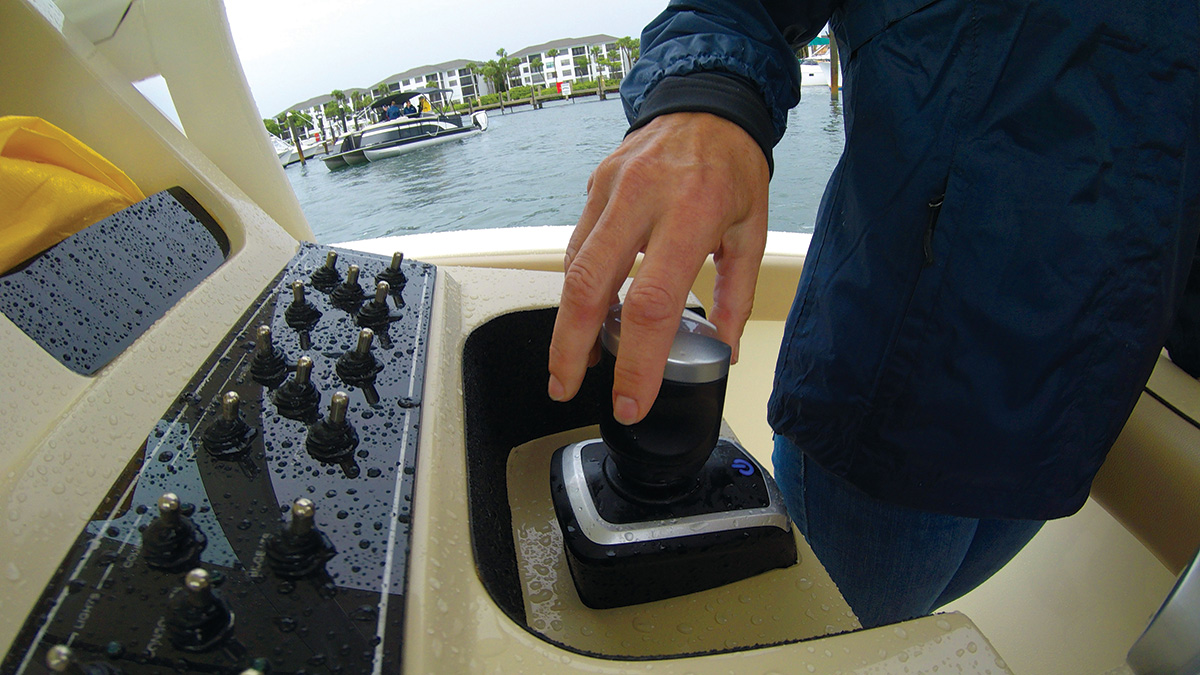 Boat steering systems are all the rage these days for the big sportfishing machines and their capabilities are simply mind-boggling. But the good news is that this technology is starting to filter down to twin outboard powered boats in the 23-to 30-range too. Teleflex introduced their SeaStar Optimus 360 Joystick a while back and it has been a great success ever since. It is also the basis of Evinrude’si-Dock System, which provides 360-degree maneuvering agility with fingertip control, allowing the operator to negotiate crowded areas, dock the vessel, or stall the boat over an inshore rip or local wreck. Smart Cylinders with rudder position sensors allow twin Evinrude E-TEC engines to be controlled independently or in tandem to maneuver the boat sideways, diagonally, forward and backwards, rotate on its axis or even crab-over sideways to accomplish tricky docking maneuvers. I actually field tested this system at a local boat show and it works as advertised.
Boat steering systems are all the rage these days for the big sportfishing machines and their capabilities are simply mind-boggling. But the good news is that this technology is starting to filter down to twin outboard powered boats in the 23-to 30-range too. Teleflex introduced their SeaStar Optimus 360 Joystick a while back and it has been a great success ever since. It is also the basis of Evinrude’si-Dock System, which provides 360-degree maneuvering agility with fingertip control, allowing the operator to negotiate crowded areas, dock the vessel, or stall the boat over an inshore rip or local wreck. Smart Cylinders with rudder position sensors allow twin Evinrude E-TEC engines to be controlled independently or in tandem to maneuver the boat sideways, diagonally, forward and backwards, rotate on its axis or even crab-over sideways to accomplish tricky docking maneuvers. I actually field tested this system at a local boat show and it works as advertised.
Yamaha’s Helm Master uses flexible, streamlined rigging that digitally connects an enhanced binnacle control, a high-definition LCD screen, electronic steering, an electronic ignition panel, a theft-deterrent system and an innovative joystick. Together these components form a true drive-by-wire system that responds instantly to your command. Helm Master is compatible with in-line F200 outboards in twin configurations and 4.2L V6 Offshore and all V8 F350 models in twin, triple or quad configurations. It’s calibrated for your specific boat and application, offers second station flexibility, with custom user settings. Mercury also offers a version of this unique outboard fingertip control system for their Verado four-strokes called Joystick Piloting for Outboards, or JPO for short. It has been upgraded for 2017 to include a special “Skyhook” feature that allows for holding position over a wreck or reef using an internal GPS and no anchor—now that really is something special!
